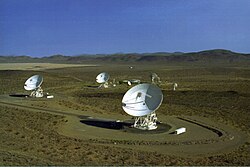Goldstone Tracking Station

The 70m antenna at Goldstone
|
|
| Organization |
California Institute of Technology Jet Propulsion Laboratory National Aeronautics and Space Administration |
|---|---|
| Observatory code |
252, 253, 257 |
| Location | Mojave Desert, California |
| Coordinates | 35°25′36″N 116°53′24″W / 35.426666666667°N 116.89°WCoordinates: 35°25′36″N 116°53′24″W / 35.426666666667°N 116.89°W |
| Altitude | 2,950 ft (900 m) |
| Established | 1958 |
| Website |
www |
| Telescopes | DSS 14 |
|
[]
|
|
|
Pioneer Deep Space Station
|
|

Pioneer Deep Space Station
|
|
| Location | Goldstone Deep Space Communications Complex, Fort Irwin, California, United States |
|---|---|
| Coordinates | 35°23′21.41″N 116°51′22.31″W / 35.3892806°N 116.8561972°W |
| Area | less than 1 acre (0.40 ha) |
| Built | 1958 |
| Architect | U.S. Army |
| NRHP reference # | 85002813 |
| Significant dates | |
| Added to NRHP | October 3, 1985 |
| Designated NHL | October 3, 1985 |
The Goldstone Deep Space Communications Complex (GDSCC), commonly called the Goldstone Observatory, is located in the Mojave Desert near Barstow in the U.S. state of California. Operated by the US NASA's Jet Propulsion Laboratory, its main purpose is to track and communicate with space missions. It is named after Goldstone, California, a nearby gold-mining ghost town.
The complex includes the Pioneer Deep Space Station, which is a U.S. National Historic Landmark. The current communications complex is one of three in the NASA Deep Space Network, the others being the Madrid Deep Space Communications Complex and the Canberra Deep Space Communication Complex.
Five large parabolic ("dish") antennas are located at the Goldstone site to handle the workload, since at any given time the DSN is responsible for maintaining communication with up to 30 spacecraft. The antennas function similarly to a home satellite dish. However, since the spacecraft they communicate with are much further away than the communication satellites which home satellite dishes use, the signals received are much weaker, requiring a larger aperture antenna to gather enough radio energy to make them intelligible. The largest, a 70-meter (230 ft) Cassegrain antenna, is used for communication with space missions to the outer planets, such as the Voyager spacecraft, at 20 billion kilometers the most distant manmade object from Earth. The radio frequencies used for spacecraft communication are in the microwave part of the radio spectrum; S band (2.29 - 2.30 GHz), X band (8.40 - 8.50 GHz) and the Ka band (31.8 - 32.3 GHz). In addition to receiving radio signals from the spacecraft (called downlink signals), the antennas transmit commands to the spacecraft (called uplink signals) with high power radio transmitters powered by klystron tubes.
...
Wikipedia


